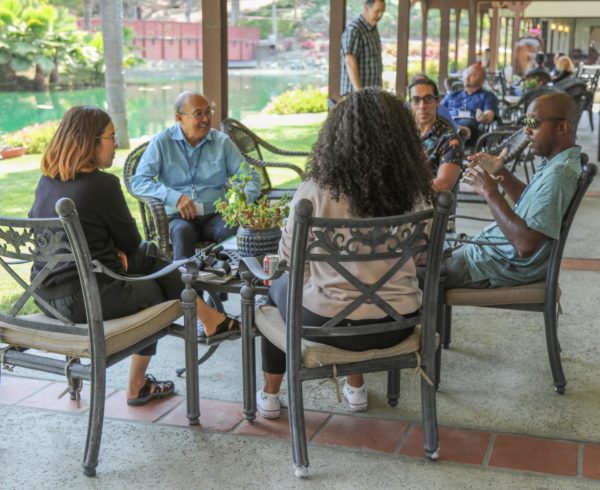Before the “sinner’s prayer,” before Christian atonement theology, before crosses became the symbol of Christianity, and before Good Friday was ever part of the Christian calender, the Friday before Easter was an incredibly sad and tragic day for early followers of Jesus. Because on that day, Jesus had died.
BEFORE GOOD FRIDAY
In the weeks leading up to that original Friday, the chief priests at the Temple in cooperation with the Pharisees (though for differing reasons) agreed that Jesus had to go. Jesus posed a threat to both groups of leaders. For the chief priests, Jesus had been undermining the work of the Temple and, by virtue, their work at the Temple and their authority among the people of Israel.
They were aware that Jesus’ following had grown all across the land of Israel. They also knew that if Jesus had decided to rally around him a large enough militia to fight against the Roman military stationed throughout Palestine, Rome might call into question the chief priests ability to manage and lead their people. They might even appear complicit if an uprising occurred. This would prove disastrous since Rome would likely turn to further violence against Israel to quell any and all perceived instigators. Since there actually had been instigators who led small battles against the Roman military every few years or so, this fear was legitimate.
Which brings us to the day before Good Friday. All across Israel, Jewish communities were preparing the annual Passover meal for that evening. Passover commemorated that time in Israel’s history during their slavery in Egypt when Yahweh sent an angel of the Lord to bring judgement on Egyptian households, but showed mercy to Israel by passing over any house whose family had placed blood on the doorposts of the house.
It was on this new Passover evening that Jesus would share what has become known as “the last supper.” In anticipation of the coming events, Jesus spoke of the bread being his body broken for them and the cup of wine which would be spilled out as an offering for many. After sharing the Passover meal with them, Judas left the room and traveled to the Temple intent on turning Jesus in. He told the chief priests where Jesus and the disciples were staying in exchange for 30 pieces of silver.
Jesus, Beaten and Flogged
It was early in the morning while it was still dark when Jesus was arrested in the Garden of Gethsemane. He was brought by Temple Guards to a secret gathering in the quarters of the high priest. Only the most ardent members of the Jewish High Court who hated or despised Jesus were invited to come. The reason the meeting was a secret was to avoid having a trial interfere with Sabbath day preparations as well as to avoid upsetting a crowd of followers and other loyalists of Jesus who might bring unwanted attention from the local Roman officials and military guard.
When Jesus arrived to the meeting, fake witnesses were brought before the chief priests and lied about what Jesus said and taught. The accounts shared as “evidence” had conflicting information. Even so, the high priest didn’t waste any time and began questioning Jesus’ allegiance to the God of Israel. When the charge of blasphemy was raised by the high priest Caiaphas, all of those present agreed that Jesus deserved to die. Some of those in the Council who were present took hold of Jesus, blindfolded him, and hit him. The servants of the chief priests also joined in, began mocking him and beat him saying “Prophecy! Tell us who just hit you.”
It was clear by how swift the secret trial went that they had already intended to have Jesus killed, but they believed that if Jesus was to be executed, it should be Rome who was responsible. Had they done it themselves, it would have risked an escalation of conflict among some of Jesus’ supporters outside the city, especially among those who liked Jesus but had not yet bought into his pacifist stance. Some zealot groups were ready to use any excuse possible to fight against Rome, and killing Jesus was no exception.
So that is exactly what the chief priests did: they presented Jesus to the Roman Governor Pontius Pilate to decide his fate. Pilate was not so impressed with Jesus because he simply did not see him as a threat. Jesus was not like other agitators and insurrectionists who drew crowds of violent extremists to fight. Jesus wasn’t violent during his public ministry, nor did he ever show signs he would ever support such a revolt against Rome.
In order to get Pilate to take their bate, they described Jesus as an agitator who forbade people from giving tribute to Caesar and who claimed his was a king. Of course, having a Jewish king in Israel was not an issue for Rome as long as Rome had approved of him; that’s exactly what happened with King Herod and his sons. No, by claiming that Jesus saw himself as their king, the chief priests were suggesting that Jesus was trying to usurp the authority of Rome and was therefore a threat. When Pilate asked them what he should do with Jesus, they shouted out “Crucify him!” But when the chief priests and Judaeans saw that Pilate was willing to release Jesus, they responded, “If you let this fellow go, you are no friend of Caesar! Everyone who sets himself up as a king is speaking against Caesar!” Not wanting to cause further questions about his own allegiance to Rome and Caesar, Pilate had Jesus flogged and then crucified.
Crucifixion
The Romans used crucifixion to instill fear in their subjects so that no one in the empire got it in their head to ever revolt against Rome and Caesar (who represented Rome’s glory). It was also used to dissuade people from various crimes: robbery, etc. Rome wasn’t the first to use this method of capital punishment, but they were the ones who made it famous. Crosses could be found all throughout the countrysides of various nations, including Israel. In addition to Jesus, thousands of individuals within Israel had also experienced Roman crucifixion, but Jesus’ story spotlighted it.
When a person was crucified by the Romans, sometimes two wood poles were used; other times it was just one. A person was stripped down naked. Their legs were placed on top of the other and a large spike was driven into the ankles or feet of the person. On the crossbeam, a person’s arms were stretched out. Sometimes Roman’s would simply tie their arms to the beam; other times, a spike was driven in each arm near the wrists of a person.
Crucifixion was meant to be humiliating and a slow painful death.
When Jesus died
There was no plan B. No alternative. No systematic theology that could explain this. No foundation of Christian doctrines that made things better. When Jesus died, all that was good about Jesus–all that he did and taught–had died with him…at least on that first Friday.
His disciples would likely have experienced a combination of emotions ranging from fear, shock, disillusionment, disappointment, and outrage. And they sat in this space for nearly 3 days because the one they knew to be the kindest, bravest, most forgiving and caring person they had ever met, the one that brought a sense of hope and peace they had never known before, was no longer with them.
Jesus had died. And until we can sit in that moment too…in that story…feeling the sensation of utter loss, we may just miss the beauty of what came next.
For other blog posts on Jesus check out the following:
Outside In, Inside out: How Jesus reframed how we think about outsiders and insiders
The Leadership Dilemma of Jesus
9/11: How Jesus’ teaching about enemies and neighbors came front and center







